Shanghai Pudong International Airport
Shanghai Pudong International Airport (IATA: PVG, ICAO: ZSPD) is one of the two international airports in Shanghai and a major aviation hub of East Asia. Pudong Airport mainly serves international flights, while the city's other major airport Shanghai Hongqiao International Airport mainly serves domestic and regional flights in East Asia. Located about 30 kilometres (19 mi) east of the city center, Pudong Airport occupies a 40-square-kilometre (10,000-acre) site adjacent to the coastline in eastern Pudong. The airport is operated by Shanghai Airport Authority (Chinese: 上海机场集团公司, SSE: 600009).
Shanghai Pudong International Airport 上海浦东国际机场 | |||||||||||||||||||||||||||
|---|---|---|---|---|---|---|---|---|---|---|---|---|---|---|---|---|---|---|---|---|---|---|---|---|---|---|---|
 | |||||||||||||||||||||||||||
.jpg) | |||||||||||||||||||||||||||
| Summary | |||||||||||||||||||||||||||
| Airport type | Public | ||||||||||||||||||||||||||
| Operator | Shanghai Airport Authority | ||||||||||||||||||||||||||
| Serves | Shanghai | ||||||||||||||||||||||||||
| Location | Pudong, Shanghai | ||||||||||||||||||||||||||
| Hub for | Passenger
Cargo | ||||||||||||||||||||||||||
| Focus city for | Hainan Airlines | ||||||||||||||||||||||||||
| Elevation AMSL | 4 m / 13 ft | ||||||||||||||||||||||||||
| Coordinates | 31°08′36″N 121°48′19″E | ||||||||||||||||||||||||||
| Website | www | ||||||||||||||||||||||||||
| Maps | |||||||||||||||||||||||||||
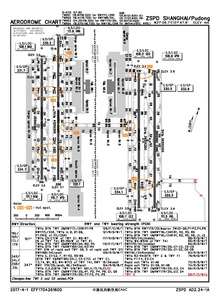 CAAC airport chart | |||||||||||||||||||||||||||
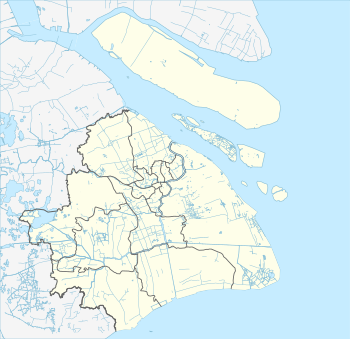 PVG/ZSPD Location of airport in Shanghai  PVG/ZSPD PVG/ZSPD (China) 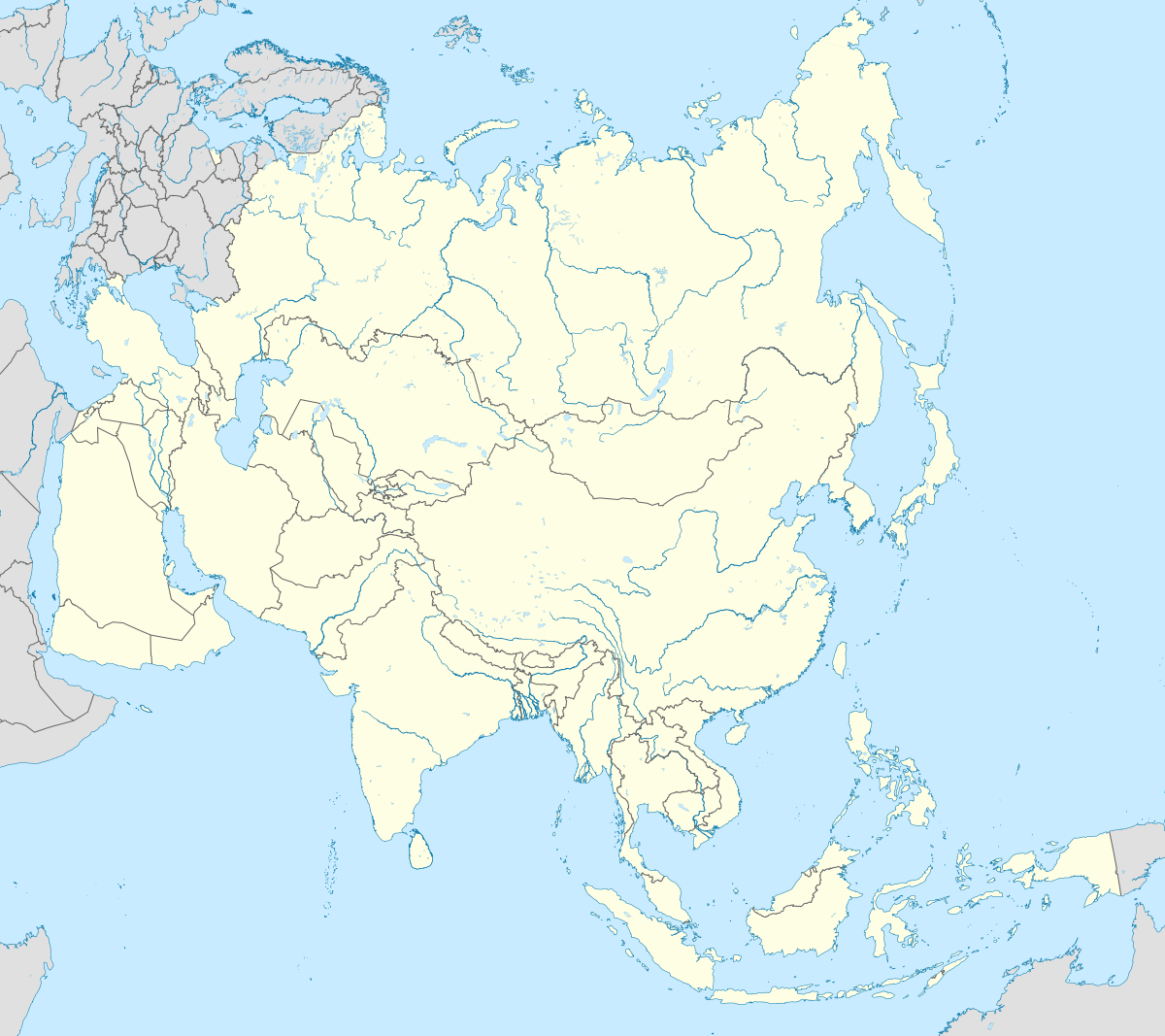 PVG/ZSPD PVG/ZSPD (Asia) | |||||||||||||||||||||||||||
| Runways | |||||||||||||||||||||||||||
| |||||||||||||||||||||||||||
| Statistics (2019) | |||||||||||||||||||||||||||
| |||||||||||||||||||||||||||
Source: List of the busiest airports in the People's Republic of China | |||||||||||||||||||||||||||
| Shanghai Pudong International Airport | |||||||||||||
|---|---|---|---|---|---|---|---|---|---|---|---|---|---|
| Simplified Chinese | 上海浦东国际机场 | ||||||||||||
| Traditional Chinese | 上海浦東國際機場 | ||||||||||||
| |||||||||||||
The airport is the main hub for China Eastern Airlines and Shanghai Airlines, and a major international hub for Air China, as well as secondary hub for China Southern Airlines. It is also the hub for privately owned Juneyao Airlines and Spring Airlines, and an Asia-Pacific cargo hub for FedEx, UPS[1] and DHL. The DHL hub, opened in July 2012, is reportedly the largest express hub in Asia.[2]
Pudong Airport has two main passenger terminals, flanked on both sides by four operational parallel runways.[3] A third passenger terminal has been planned since 2015, in addition to a satellite terminal and two additional runways, which will raise its annual capacity from 60 million passengers to 80 million, along with the ability to handle six million tons of freight.[4]
Pudong Airport is a fast-growing hub for both passenger and cargo traffic. With 3,703,431 metric tons handled in 2017, the airport is the world's third-busiest airport by cargo traffic. Pudong Airport also served a total of 74,006,331 passengers in 2018, making it the third-busiest airport in China after Beijing Capital and Hong Kong Airport, fifth-busiest in Asia, and the eighth-busiest in the world. It is also the busiest international gateway of mainland China, with 35.25 million international passengers.[5] By the end of 2016, Pudong Airport hosted 104 airlines serving more than 210 destinations.[6]
Shanghai Pudong is the busiest international hub in China, and about half of its total passenger traffic is international.[7] Pudong Airport is connected to Shanghai Hongqiao Airport by Shanghai Metro Line 2 and the Shanghai Maglev Train via Pudong International Airport Station. There are also airport buses connecting it with the rest of the city.

History
Early development
Prior to the establishment of Pudong International Airport, Shanghai Hongqiao International Airport was the primary airport of Shanghai. During the 1990s, the expansion of Hongqiao Airport to meet growing demand became impossible as the surrounding urban area was developing significantly, and an alternative to assume all international flights had to be sought.
After deliberation, the municipal government decided to adopt the suggestion from Professor Chen Jiyu of East China Normal University, who wrote a letter to the Mayor of Shanghai Xu Kuangdi suggesting that the new airport should be constructed on the tidal flats of the south bank of the Yangtze River estuary, on the coast of the Pudong development zone to the east of Shanghai.
Construction of the first phase of the new Shanghai Pudong International Airport began in October 1997, took two years to build at a cost of RMB 12 billion (US$1.67 billion), and was opened on October 1, 1999 It covers an area of 40 square kilometres (15 sq mi) and is 30 kilometres (19 mi) from downtown Shanghai. The first phase of the airport has one 4E category runway (4000 m x 60 m) along with two parallel taxiways, an 800,000-square-metre (8,600,000 sq ft) apron, seventy-six aircraft positions and a 50,000 m2 (540,000 sq ft) cargo warehouse.
A second runway was opened on March 17, 2005, and construction of phase two (including a second terminal, a third runway and a cargo terminal) began in December 2005 and started operation on March 26, 2008, in time for the Beijing 2008 Summer Olympics.
In November 2011, Pudong Airport received approval from the national government for a new round of expansion which includes two runways. The 3,800-metre fourth runway, along with an auxiliary taxiway and traffic control facilities, is projected to cost 2.58 billion yuan (US$403 million). The 3,400-metre fifth runway, along with a new traffic tower, will cost 4.65 billion yuan (US$726.6 million). Construction was completed in 2015 and has doubled the capacity of the airport.[8][9]
Ongoing expansion
Pudong International Airport officially started the third phase of the Pudong International Airport expansion with the construction on a new south satellite terminal on December 29, 2015. The new satellite terminal will be the world's largest single satellite terminal with a total construction area of 622,000 square meters, which is larger than the Pudong International Airport T2 terminal building (485,500 square meters). The satellite terminal is composed of two halls, S1 and S2, forming an H-shaped structure. It will have an annual design capacity of 38 million passengers, The total cost of the project is estimated to be about 20.6 billion yuan. Halls S1 and S2 will have 83 gates.[10] A high capacity People mover connecting T1 to SI and T2 to S2 will be constructed. After the completion of the satellite terminal in 2019, Pudong International Airport will have an annual passenger capacity of 80 million passengers, ranking among the top ten airports in the world.[11]
As of October 2019, the satellite S1 is in operation and connected by MRT to T1.
Facilities
The airport has 162 boarding bridges(T1-31 T2-41 Satellite terminal-90) along with 189 remote gates. Four runways are parallel to the terminals (four operational): one 4,000-metre (13,000 ft) runway with 4E rating (capable of accommodating aircraft up to Boeing 747-400), two 3,800-metre (12,500 ft) runways with 4F rating (capable of accommodating aircraft up to Airbus A380, Boeing 747-8, and Antonov An-225), and two 3,400-metre (11,200 ft) runways with 4F rating .
Pudong airport currently has four runways. Rwy 35L/17R and Rwy 34R/16L are mostly used for landing while Rwy 35R/17L and Rwy 34L/16R are mostly used for takeoff. Runway 15/33 is not in operation.
Terminal 1
Terminal 1 was opened on October 1, 1999 along with a 4000-metre runway and a cargo hub.[12] It was built to handle the demand for traffic and to relieve Shanghai Hongqiao International Airport's traffic. The exterior of Terminal 1 is shaped like a seagull, and has 28 gates, 13 of which are double-decker gates. The capacity of Terminal 1 is 20 million passengers. It currently has 204 check-in counters, thirteen luggage conveying belts and covers an area of 280,000 square metres.
The gates for Terminal 1 is 1–12, 14–32 (linked with jetway), while the remote gates are 200-203 251-258(Domestic), 208-212 213-216(International).
Terminal 2
Terminal 2, opened to public and officially opened on March 26, 2008, along with the third runway, is capable of handling 60 million passengers and 4.2 million tons of cargo annually. Terminal 2 is shaped like Terminal 1, although it more closely resembles a wave, and is slightly larger than Terminal 1. Terminal 2 also has more floor areas than Terminal 1. Terminal 2 is primarily used by Air China and other Star Alliance members.[13]
The gates for Terminal 2 are 50–65, 67–79, 80–98 (Note that gates 58–90 are used by both the C gates (used for domestic flights) and the D gates (used for international flights). The gates between gates 65–79 are only odd numbered (65, 67, 69, 71, 73, 75, 77, 79). Gates 50–57 and gates 92–98 are used for C gates only. The remote gates for Terminal 2 are C219-C224 for domestic and D228-D232 for international.
Satellite concourses
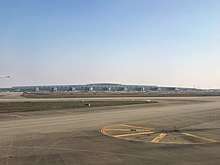
Construction on an additional satellite concourse facility that could accommodate further gates and terminal space started on December 29, 2015 and was inaugurated in September 2019.[14] It is the largest stand-alone satellite airport terminal buildings in the world. This project will support 38 million passengers annually through 90 departure gates across two S1 and S2 concourses.Both S1 and S2 are connected together and these will be connected by an underground automated people mover to the current T1 and T2 terminals.[15] Gates for Domestic flights are labelled H in both S1 and S2 terminal,While G is labelled for International flights gates in both S1 and S2 terminal.
The gates for S1 terminal are H101-H147 for domestic flights(remote gates are H501-H502), G101-G108 G114-G123 G133-G147 for international arrivals, G101-G102 G115-G123 G133-G140 for international departures(remote gates are G551-G552).
The gates for S2 terminal are H148-H190 for domestic flights(remote gates are (H601-H602), G148-G145 G166-G177 G183-G190 for international arrivals, G150-G154 G167-G174 G189-G190 for international departures(remote gates are G651-G652)
Gates 101-102 115-123 133-140(S1) 150-154 167-174 189-190(S2) can be used for both international and domestic arrivals and departures,Gates 103-108 114 141-147(S1) 148-149 155 166 175-177 183-190(S2) can be used for both domestic arrivals and departures,but can only be used for international arrivals.Gates 109-113 124-132(S1) 156-165 178-182(S2) can only be used for domestic departures and arrivals.
A380/B747-8 stands
Gates that can accommodate the A380/B747-8 are 24(T1) 71,75(T2) 119,121(S1) 504-507(remote stands near S1,on taxiway L02,between taxiway P3 and south of P2) 168, 170, 173 (S2)
A-CDM implementation
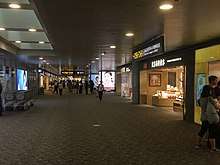
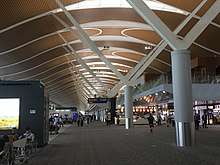
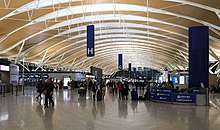
The airport has been using the Airport Collaborative Decision Making system (A-CDM) developed by the aviation data service company VariFlight since January 2017. The system is aimed to improve on-time performance and safety of the airport's operations. By June 2017, Shanghai Pudong airport recorded 62.7% punctuality rate, which was a 15% increase compared to the same period previous year.[16]
Airlines and destinations
Passenger
Cargo
Statistics
| Year | Passengers | % change | Aircraft movements | Cargo (tons) |
|---|---|---|---|---|
| 2006[57] | 26,788,586 | 231,994 | ||
| 2007[58] | 28,920,432 | 253,532 | 2,559,098 | |
| 2008[58] | 28,235,691 | 265,735 | 2,603,027 | |
| 2009[59] | 31,921,009 | 287,916 | 2,543,394 | |
| 2010[60] | 40,578,621 | 332,126 | 3,228,081 | |
| 2011[61] | 41,447,730 | 344,086 | 3,085,268 | |
| 2012[62] | 44,880,164 | 361,720 | 2,938,157 | |
| 2013[63] | 47,189,849 | 371,190 | 2,928,527 | |
| 2014[64] | 51,687,894 | 402,105 | 3,181,654 | |
| 2015 | 60,098,073 | 449,171 | 3,275,231 | |
| 2016[65] | 66,002,414 | 479,902 | 3,440,280 | |
| 2017[66] | 70,001,237 | 496,774 | 3,835,600 | |
| 2018[67] | 74,006,331 | 504,794 | 3,768,573 |
Ground transportation


Highway
- North: S1 Yingbin Expressway and Huaxia Elevated Road
- South: Shanghai–Jiaxing–Huzhou Expressway and G1501 Shanghai Ring Expressway
Maglev train
- Maglev : Starting service on January 29, 2004, as the first commercial high-speed maglev railway in the world, Shanghai Maglev Train links Pudong International Airport with Longyang Road Metro Station, where transfer to Line 2, Line 7, and Line 16 is possible. The 30 km (19 mi) ride from Longyang Road Metro station to Pudong International Airport typically takes less than eight minutes, with the maximum speed reaching 431 km/h (268 mph). Trains operate every 15 minutes; therefore passengers can expect to arrive in less than 25 minutes, waiting time included.
All cars are equipped with racks and space designated for luggage.
Shanghai Metro Line 2
- 2 : Shanghai Metro Line 2 also provides service between Pudong International Airport and Longyang Road, Lujiazui, People's Square, and Hongqiao International Airport, Shanghai's primary domestic airport as well as Shanghai Hongqiao Railway Station. Line 2 is part of the Shanghai Metro system; therefore unlike the Maglev, free in-system transfer to other lines are possible.
Prices and speeds are substantially lower than the Maglev. A casual ride to People's Square, the city center, typically takes just over one hour, while a trip to Hongqiao International Airport takes about 1.5 hour.
The east extension of Line 2 used to run in an independent pattern between Guanglan Road and Pudong Airport, in which the train would not run west of Guanglan Road and passengers had to transfer at this station. The regular service between East Xujing and Pudong Airport started in April 2019,[68] allowing passengers to access the city center without the extra transfer. The regular service completely replaced the independent east extension service in October of the same year when the four-carriage trainsets special for the service started to be transformed into eight-carriage trainsets for the regular service.[69]
Future plan
The plan for building a new commuter railway line connecting the airport with Hongqiao Airport, Airport Link, has been formally established in 2015 and approved in December 2018 by National Development and Reform Commission. This railway starts from Shanghai East railway station under planning, via Disneyland, Zhangjiang and Sanlin in Pudong, Huajing in Xuhui and Qibao in Minhang.[70] It will use the unused area in Hongqiao Railway Station originally for Maglev for its station at Hongqiao Transportation Hub.
Airport buses
Eight airport bus lines serve the airport, providing rapid links to various destinations.
- Airport Bus Route 1: To Shanghai Hongqiao Railway Station via Shanghai Hongqiao International Airport
- Airport Bus Route 2: To Jing'an Temple (City Terminal Hub)
- Airport Bus Route 4: To Hongkou Stadium Hub (Huayuan Road), via Deping Road at Pudong Avenue, Wujiaochang and Dabaishu
- Airport Bus Route 5: To Shanghai Railway Station, via Longyang Road Metro Station, Century Avenue at South Pudong Road (Lujiazui) and East Yan'an Road at Middle Zhejiang Road (People's Square)
- Airport Bus Route 7: To Shanghai South Railway Station, via West Huaxia Road at Shangnan Road and East Huaxia Road at Chuansha Road (Chuansha)
- Airport Bus Route 8: To Nanhui Coach and Bus Station
- Airport Bus Route 9: To Xinzhuang Metro Station
- Airport Bus Ring Route 1: To Hangchengyuan (Shiwan), via stops in Airport Workplace
Accidents and incidents
- On November 28, 2009, Avient Aviation Flight 324, an Avient Aviation McDonnell Douglas MD-11F cargo plane registered to Zimbabwe (registration: Z-BAV) departing for Kyrgyzstan crashed into a warehouse near the runway of the airport due to a tailstrike that caught fire during takeoff and broke into several pieces with seven people on board. Three people died and four were injured.[71][72][73]
- On July 22, 2020, an Ethiopian Airlines Cargo Boeing 777 freighter aircraft caught fire while at Pudong International Airport as it prepared for a trip to Sao Paulo, Brazil and to Santiago, Chile via Addis Ababa, shortly after landing from Brussels, Belgium. No injuries were reported.[74]
Photo gallery
 Airport exterior
Airport exterior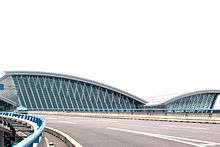 The S1 Yingbin Expressway goes into the airport.
The S1 Yingbin Expressway goes into the airport.- Interior of Terminal 1
See also
References
- "UPS Air Operations Facts - UPS Pressroom". Archived from the original on 12 May 2015. Retrieved 1 June 2015.
- "Deutsche Post DHL targets Asian expansion". 11 July 2012. Retrieved 1 June 2015.
- Jian, Yang (28 January 2015). "4th Pudong runway opens in March". Shanghai Daily.
- Shanghai Airport reports profit growth, despite big investments in massive new facilities at Pudong – China Airlines, Airports and Aviation News. Chinaaviation.aero (2008-03-11). Retrieved on 2011-01-22.
- 上海浦东机场口岸出入境人数首破3500万. www.chinanews.com (in Chinese). 27 December 2017. Retrieved 18 December 2018.
- 民航局与上海市人民政府在沪签战略合作协议 (in Chinese). Carnoc. 6 April 2012.
- "From obscurity, Guangzhou and Shanghai Pudong airports move up rankings". CAPA. 3 June 2011.
- "Shanghai Pudong's fourth and fifth runways receive approval". CAPA. 6 December 2011.
- "Shanghai airport to double capacity". South China Morning Post. 8 December 2011.
- Cheng, Zhaoyuan (成昭远). 浦东机场三期扩建启动 世界最大单体卫星厅总面积超T2[图]-浦东,航站楼,上海,卫星,旅客,机位,厅,中转,机场,单体,-上海频道-东方网. sh.eastday.com (in Chinese). Retrieved 4 November 2018.
- 上海机场(集团)有限公司. www.shanghaiairport.com (in Chinese). Retrieved 4 November 2018.
- GmbH, Vendana. "Airports | Air ambulance | Rescue flight". www.medical-air-service.com. Retrieved 7 April 2020.
- Dermot Davitt Shanghai Pudong International Airport begins new era with opening of Terminal Two 26/03/08, Source: The Moodie Report
- "World's largest satellite terminal to open at Pudong airport next week". SHINE. Retrieved 1 November 2019.
- "Shanghai Pudong Airport starts construction world's largest satellite terminal". Shanghai Airport Authority. 12 January 2016. Retrieved 1 May 2016.
- 飞常准:用科技助力民航高效发展,推动智慧航旅服务升级. Soho. 1 February 2018. Retrieved 17 April 2018.
- "Air China inaugurates Barcelona-Shanghai direct flight - Xinhua - English.news.cn". www.xinhuanet.com. Retrieved 23 February 2019.
- Liu, Jim. "Air China outlines Beijing Daxing operations from late-Oct 2019". Routesonline. Retrieved 4 October 2019.
- https://www.airchina.co.uk/CAOnline/dyn/air/booking/availability#!
- https://centreforaviation.com/news/air-china-relocate-from-london-gatwick-to-london-heathrow-airport-986559
- "Cambodia Angkor Air to launch new route in China 3Q19". CambodiaAngkorAir. Retrieved 22 October 2019.
- "Cebu Pacific adds Cebu Shanghai Service". Routesonline. Retrieved 25 March 2019.
- Liu, Jim. "China Eastern outlines Beijing Daxing network from late-Oct 2019". Routesonline. Retrieved 24 September 2019.
- http://www.xinhuanet.com/english/2019-10/19/c_138483668.htm
- Ltd. 2019, UBM (UK). "China Eastern adds Shanghai – Hanamaki service in late-Jan 2019". Routesonline. Retrieved 23 February 2019.
- 新航季航班时刻表-黑龙江地区. WeChat (in Chinese).
- 嘿!2018年冬春新航季,来聊点航线新动态!. WeChat (in Chinese). Retrieved 23 February 2019.
- 新航线 · 井冈山¥360起 ▎1月18日起,东航新开【昆明-井冈山-上海浦东】航线!. WeChat (in Chinese). Retrieved 23 February 2019.
- "China Eastern 9 Shanghai – London Gatwick service from Dec 2018". routesonline. Retrieved 5 August 2018.
- "China Eastern plans Shanghai – Mandalay launch in Jan 2019". routesonline. Retrieved 14 December 2018.
- 出行又添新选择 东航云南3月底将新开11条航线]. 163.com news. 2 March 2018.
- 重磅!“魔都”来啦,西昌直飞上海7月14日首航!东方明珠,外滩,迪士尼乐园......]. eastday.com news. 27 June 2019.
- 新航季 · 2019夏秋新航线 ① | 启程!探索新旅程!. WeChat (in Chinese).
- "China Eastern adds Shanghai – Yangon service from June 2019". routesonline. Retrieved 11 April 2019.
- "China Eastern closes Brisbane bookings in NS20". Routes Online. Retrieved 5 February 2020.
- Liu, Jim. "China Eastern converts Stockholm to seasonal service in 1H20". routesonline. Retrieved 14 May 2020.
- "China Southern adds Shanghai – Bangkok service from late-July 2019".
- Liu, Jim. "China Southern expands Tokyo Narita network in W19". Routesonline. Retrieved 25 September 2019.
- 이스타항공, 인천~상하이 정기편 첫 운항…국적 LCC 최초 (in Korean). 14 July 2019.
- https://www.routesonline.com/news/38/airlineroute/289393/hong-kong-airlines-febmar-2020-service-changes-as-of-06feb20/
- "Juneyao Airlines schedules Helsinki launch in late-June 2019". Retrieved 4 February 2018.
- Liu, Jim. "Juneyao Airlines adds Tokyo Narita service from late-Oct 2019". Routesonline. Retrieved 16 September 2019.
- Liu, Jim (16 June 2019). "Juneyao Airlines adds Vladivostok service from late-June 2019". Routesonline. Retrieved 17 June 2019.
- https://www.routesonline.com/news/38/airlineroute/287047/juneyao-airlines-adds-shanghai-yonago-service-in-jan-2020/
- "Lao Airlines S19 Shanghai frequency variations".
- "Philippine Airlines International Timetable" (PDF). Retrieved 19 December 2018.
- "Shanghai Airlines adds Chengdu – Budapest service from late-Dec 2019". RoutesOnline=date=22 November 2019. Retrieved 22 November 2019.
- Ltd. 2019, UBM (UK). "Shanghai Airlines adds Shanghai Pu Dong – Macau from March 2018". Routesonline. Retrieved 23 February 2019.
- "Shanghai Airlines opens Xi'An – Budapest reservations from late-Dec 2019". RoutesOnline. 10 November 2019. Retrieved 10 November 2019.
- https://www.routesonline.com/news/38/airlineroute/286793/sky-angkor-air-schedules-new-routes-in-oct-2019/
- Liu, Jim (25 September 2019). "Spring Airlines 4Q19 International network additions". Routesonline. Retrieved 25 September 2019.
- "First Shanghai-Yangon direct flight to open in July". Shine.cn. 21 May 2019. Retrieved 21 May 2019.
- "Thai Lion Air expands scheduled service to China from Nov 2017". routesonline. Retrieved 29 January 2018.
- "Từ 19/1/2020, Vietnam Airlines sẽ khai thác đường bay Đà Nẵng – Thượng Hải" (in Vietnamese). Bnews. 26 December 2019. Retrieved 26 December 2019.
- GmbH, DVV Media Group (17 June 2017). "Air China Cargo lands at Liege Airport ǀ Air Cargo News". www.aircargonews.net.
- "China Cargo Airlines begins cargo flights between Shanghai-Pudong and Frankfurt". www.ajot.com. Retrieved 23 February 2019.
- 2007年全国机场吞吐量排名 (in Chinese). Civil Aviation Administration of China. 6 March 2008. Archived from the original on 2017-10-07. Retrieved 2017-10-08.
- 2008年全国机场吞吐量排名 (in Chinese). Civil Aviation Administration of China. 12 March 2009. Archived from the original on 24 May 2011. Retrieved 29 March 2011.
- 2009年全国机场吞吐量排名 (in Chinese). Civil Aviation Administration of China. 5 February 2010. Archived from the original on 18 July 2011. Retrieved 29 March 2011.
- 2010年全国机场吞吐量排名 (in Chinese). Civil Aviation Administration of China. 15 March 2011. Archived from the original on 23 September 2011. Retrieved 29 March 2011.
- 2011年全国机场吞吐量排名 (in Chinese). Civil Aviation Administration of China. 21 March 2012. Archived from the original on 17 April 2012. Retrieved 23 March 2012.
- 2012年全国机场吞吐量排名 (in Chinese). Civil Aviation Administration of China. 28 March 2013. Archived from the original on 7 October 2017. Retrieved 8 October 2017.
- 2013年民航机场吞吐量排名 (in Chinese). Civil Aviation Administration of China. 24 March 2013. Archived from the original on 25 March 2014. Retrieved 29 March 2013.
- 2014年民航机场吞吐量排名 (in Chinese). Civil Aviation Administration of China. 3 April 2015. Archived from the original on 19 April 2015. Retrieved 2015-04-03.
- 2016年民航机场生产统计公报. CAAC. 24 February 2017.
- 2017年民航机场生产统计公报 (in Chinese). Civil Aviation Administration of China. 7 March 2018. Retrieved 15 March 2018.
- 2018年民航机场生产统计公报 (in Chinese). Civil Aviation Administration of China. 24 March 2019. Retrieved 5 March 2019.
- New routes for Line 2 following upgrades
- Farewell to four-carriage trains
- Speed and convenience: Metro combines best of both worlds
- Cargo plane crashes at Shanghai airport – Xinhua. Reuters. Retrieved on 2011-01-22.
- 浦东机场货机坠毁现场浓烟滚滚 (in Chinese). Sina. Retrieved 22 January 2011.
- "3 Americans killed in Shanghai plane crash". Retrieved 1 June 2015.
- https://www.flightglobal.com/ethiopian-777f-suffers-major-fire-in-shanghai/139423.article
External links
| Wikimedia Commons has media related to Shanghai Pudong International Airport. |
| Wikivoyage has a travel guide for Shanghai Pudong International Airport. |

